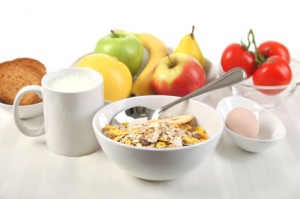Before we knew it, summertime was over, and it was time for our kids to go back to school. We may no longer be able to fix elaborate breakfasts before the kids rush to school; but there are certainly plenty of breakfast choices that are healthy, tasty, and easy to prepare.
We all know by now that eating breakfast is important, as it fuels our bodies and minds for the day ahead. But what kind of breakfasts are nutritious and healthy?
Your family as a whole should focus on eating whole, natural foods, and avoiding processed, pre-packaged foods for the most part. Some processed foods are okay, so long as you become a label-reader, which is the only way you’ll know exactly what’s in the package. We know to avoid excess sugars and fats; but we should also be watchful of artificial additives, such as preservatives, flavorings, colorings, and stabilizing agents, all of which add no nutritional value and in fact can only be toxic to your system and harm your health, being that they’re unnatural chemicals made in a laboratory and not grown in the soil.
Well, that leaves out most if not all kids’ breakfast cereals advertised on TV, doesn’t it? Yes, it does.
A healthy breakfast can consist of whole-grain cereal with no artificial additives. Good examples of healthy breakfast cereals are Raisin Bran, Grape Nuts, various bran flakes and corn flakes. Make sure your cereal does not contain “BHT,” an artificial chemical preservative used in some brands of flakes, but not in others. Sometimes, BHT is only added to the packaging, as in the case of Kellogg’s corn flakes; but this is still an unnecessary chemical and should be avoided. Look for cereals that use no preservatives, or that use mixed tocopherols (vitaimin E) as the preservative.
Cereal should be served with milk, preferably organic, which is healthier, tastes better, and does not upset people’s stomachs the way non-organic milk can (organic milk does not have residues of chemical pesticides, fertilizers or antibiotics in it, so it is easier to digest).
For variety and added flavor, try mixing chopped fruits or nuts with the cereal.
Eggs are another great way to start the day. Use olive or coconut oil for frying eggs, as these oils are very good for your health. You can scramble or fry eggs on their own, or add chopped vegetables like bell peppers or tomatoes, and natural cheeses, to change up the flavor and add nutrition (plus dietary fiber from the vegetables).
To go with your eggs, look for natural, preservative-free breads. Preservative- and additive-free breads are a little hard to find at supermarkets in this day and age, but it’s worth taking the time to look for them. Your bread should only have 4 or 5 ingredients, all natural. If you see a long list of ingredients on the bread’s packaging, you know that most of them will be artificial and unnecessary. Butter your bread with real butter or eat plain for fewer calories; never use margarine, which has artificial ingredients and has been linked in studies to heart disease.
Another great breakfast is oatmeal. The quick kind only takes a minute to cook. Instead of buying the small, flavored packets of oatmeal, which contain artificial ingredients, buy a big container of Quaker oats, or a store brand, and cook it with chopped bananas, raisins, nuts, etc.
Chopped fruit and yogurt make a great snack, or a healthy quick, light breakfast on days your kids may be running late. Or they can always eat a banana or a natural granola bar and guzzle a glass of milk with it.
You can accompany your child’s breakfast with a small glass of fruit juice. For a bigger thirst, try diluting the juice with plenty of filtered or bottled water. Carbonated water adds a great kick to the juice and makes it taste a lot like a soda, without all the harmful chemicals present in nearly all sodas.
Sodas should be avoided as a whole, not only because of the chemicals but because they offer no nutrition, other than the empty calories in the sugar. Another beverage to avoid are so-called “juice drinks” (such as Sunny D and Tampico) that in truth have only 2 percent juice or no juice, and are a glassful of artificial chemicals that don’t belong in your child’s system.
By Jamell Andrews
